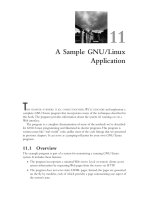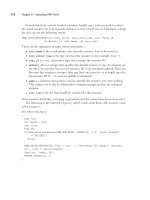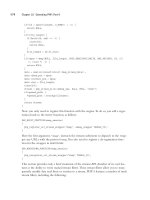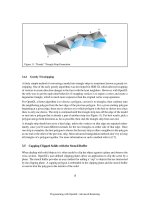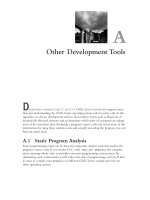Advanced PHP programming
Bạn đang xem bản rút gọn của tài liệu. Xem và tải ngay bản đầy đủ của tài liệu tại đây (16.38 MB, 673 trang )
www.it-ebooks.info
Advanced PHP
Programming
www.it-ebooks.info
www.it-ebooks.info
Advanced PHP
Programming
A practical guide to developing large-scale
Web sites and applications with PHP 5
George Schlossnagle
DEVELOPER’S
LIBRARY
Sams Publishing, 800 East 96th Street, Indianapolis, Indiana 46240 USA
www.it-ebooks.info
Advanced PHP Programming
Copyright © 2004 by Sams Publishing
All rights reserved. No part of this book shall be reproduced, stored
in a retrieval system, or transmitted by any means, electronic,
mechanical, photocopying, recording, or otherwise, without written
permission from the publisher. No patent liability is assumed with
respect to the use of the information contained herein. Although
every precaution has been taken in the preparation of this book, the
publisher and author assume no responsibility for errors or omissions. Nor is any liability assumed for damages resulting from the use
of the information contained herein.
International Standard Book Number: 0-672-32561-6
Library of Congress Catalog Card Number: 2003100478
Printed in the United States of America
First Printing: March 2004
06 05 04
4 3 2 1
Trademarks
All terms mentioned in this book that are known to be trademarks
or service marks have been appropriately capitalized. Sams
Publishing cannot attest to the accuracy of this information. Use of a
term in this book should not be regarded as affecting the validity of
any trademark or service mark.
Warning and Disclaimer
Every effort has been made to make this book as complete and as
accurate as possible, but no warranty or fitness is implied.The information provided is on an “as is” basis.The author and the publisher
shall have neither liability nor responsibility to any person or entity
with respect to any loss or damages arising from the information
contained in this book.
Bulk Sales
Pearson offers excellent discounts on this book when ordered in
quantity for bulk purchases or special sales. For more information,
please contact
U.S. Corporate and Government Sales
1-800-382-3419
For sales outside of the U.S., please contact
International Sales
1-317-428-3341
www.it-ebooks.info
Acquisitions Editor
Shelley Johnston
Development Editor
Damon Jordan
Managing Editor
Charlotte Clapp
Project Editor
Sheila Schroeder
Copy Editor
Kitty Jarrett
Indexer
Mandie Frank
Proofreader
Paula Lowell
Technical Editors
Brian France
Zak Greant
Sterling Hughes
Publishing Coordinator
Vanessa Evans
Interior Designer
Gary Adair
Cover Designer
Alan Clements
Page Layout
Michelle Mitchell
Contents
Contents at a Glance
Introduction
I Implementation and Development
Methodologies
1 Coding Styles
2 Object-Oriented Programming Through Design
Patterns
3 Error Handling
4 Implementing with PHP:Templates and the Web
5 Implementing with PHP: Standalone Scripts
6 Unit Testing
7 Managing the Development Environment
8 Designing a Good API
II Caching
9 External Performance Tunings
10 Data Component Caching
11 Computational Reuse
III Distributed Applications
12 Interacting with Databases
13 User Authentication and Session Security
14 Session Handling
15 Building a Distributed Environment
16 RPC: Interacting with Remote Services
www.it-ebooks.info
v
vi
Contents
IV Performance
17 Application Benchmarks:Testing an Entire
Application
18 Profiling
19 Synthetic Benchmarks: Evaluating Code Blocks and
Functions
V Extensibility
20 PHP and Zend Engine Internals
21 Extending PHP: Part I
22 Extending PHP: Part II
23 Writing SAPIs and Extending the Zend Engine
Index
www.it-ebooks.info
Contents
Table of Contents
Introduction
1
I Implementation and Development
Methodologies
1 Coding Styles
9
Choosing a Style That Is Right for You 10
Code Formatting and Layout 10
Indentation 10
Line Length 13
Using Whitespace 13
SQL Guidelines 14
Control Flow Constructs 14
Naming Symbols 19
Constants and Truly Global Variables 21
Long-Lived Variables 22
Temporary Variables 23
Multiword Names 24
Function Names 24
Class Names 25
Method Names 25
Naming Consistency 25
Matching Variable Names to Schema Names 26
Avoiding Confusing Code 27
Avoiding Using Open Tags 27
Avoiding Using echo to Construct HTML 27
Using Parentheses Judiciously 28
Documentation 29
Inline Comments 29
API Documentation 30
Further Reading 35
www.it-ebooks.info
vii
viii
Contents
2 Object-Oriented Programming Through
Design Patterns 37
Introduction to OO Programming 38
Inheritance 40
Encapsulation 41
Static (or Class) Attributes and Methods 41
Special Methods 42
A Brief Introduction to Design Patterns 44
The Adaptor Pattern 44
The Template Pattern 49
Polymorphism 50
Interfaces and Type Hints 52
The Factory Pattern 54
The Singleton Pattern 56
Overloading 58
SPL 63
_ _call() 68
_ _autoload() 70
Further Reading 71
3 Error Handling
73
Handling Errors 75
Displaying Errors 76
Logging Errors 77
Ignoring Errors 78
Acting On Errors 79
Handling External Errors 80
Exceptions 83
Using Exception Hierarchies 86
A Typed Exceptions Example 88
Cascading Exceptions 94
Handling Constructor Failure 97
Installing a Top-Level Exception Handler 98
Data Validation 100
When to Use Exceptions 104
Further Reading 105
www.it-ebooks.info
Contents
4 Implementing with PHP: Templates
and the Web 107
Smarty 108
Installing Smarty 109
Your First Smarty Template: Hello World! 110
Compiled Templates Under the Hood 111
Smarty Control Structures 111
Smarty Functions and More 114
Caching with Smarty 117
Advanced Smarty Features 118
Writing Your Own Template Solution 120
Further Reading 121
5 Implementing with PHP: Standalone
Scripts 123
Introduction to the PHP Command-Line Interface
(CLI) 125
Handling Input/Output (I/O) 125
Parsing Command-Line Arguments 128
Creating and Managing Child Processes 130
Closing Shared Resources 131
Sharing Variables 132
Cleaning Up After Children 132
Signals 134
Writing Daemons 138
Changing the Working Directory 140
Giving Up Privileges 140
Guaranteeing Exclusivity 141
Combining What You’ve Learned: Monitoring
Services 141
Further Reading 150
6 Unit Testing
153
An Introduction to Unit Testing 154
Writing Unit Tests for Automated Unit
Testing 155
Writing Your First Unit Test 155
Adding Multiple Tests 156
www.it-ebooks.info
ix
x
Contents
Writing Inline and Out-of-Line Unit Tests 157
Inline Packaging 158
Separate Test Packaging 159
Running Multiple Tests Simultaneously 161
Additional Features in PHPUnit 162
Creating More Informative Error Messages 163
Adding More Test Conditions 164
Using the setUp() and tearDown()
Methods 165
Adding Listeners 166
Using Graphical Interfaces 167
Test-Driven Design 168
The Flesch Score Calculator 169
Testing the Word Class 169
Bug Report 1 177
Unit Testing in a Web Environment 179
Further Reading 182
7 Managing the Development
Environment 183
Change Control 184
CVS Basics 185
Modifying Files 188
Examining Differences Between Files 189
Helping Multiple Developers Work on
the Same Project 191
Symbolic Tags 193
Branches 194
Maintaining Development and Production
Environments 195
Managing Packaging 199
Packaging and Pushing Code 201
Packaging Binaries 203
Packaging Apache 204
Packaging PHP 205
Further Reading 206
www.it-ebooks.info
Contents
8 Designing a Good API
207
Design for Refactoring and Extensibility 208
Encapsulating Logic in Functions 208
Keeping Classes and Functions Simple 210
Namespacing 210
Reducing Coupling 212
Defensive Coding 213
Establishing Standard Conventions 214
Using Sanitization Techniques 214
Further Reading 216
II Caching
9 External Performance Tunings
219
Language-Level Tunings 219
Compiler Caches 219
Optimizers 222
HTTP Accelerators 223
Reverse Proxies 225
Operating System Tuning for High
Performance 228
Proxy Caches 229
Cache-Friendly PHP Applications 231
Content Compression 235
Further Reading 236
RFCs 236
Compiler Caches 236
Proxy Caches 236
Content Compression 237
10 Data Component Caching
239
Caching Issues 239
Recognizing Cacheable Data Components 241
Choosing the Right Strategy: Hand-Made or
Prefab Classes 241
Output Buffering 242
In-Memory Caching 244
www.it-ebooks.info
xi
xii
Contents
Flat-File Caches 244
Cache Size Maintenance 244
Cache Concurrency and Coherency 245
DBM-Based Caching 251
Cache Concurrency and Coherency 253
Cache Invalidation and Management 253
Shared Memory Caching 257
Cookie-Based Caching 258
Cache Size Maintenance 263
Cache Concurrency and Coherency 263
Integrating Caching into Application Code 264
Caching Home Pages 266
Using Apache’s mod_rewrite for Smarter
Caching 273
Caching Part of a Page 277
Implementing a Query Cache 280
Further Reading 281
11 Computational Reuse
283
Introduction by Example: Fibonacci Sequences 283
Caching Reused Data Inside a Request 289
Caching Reused Data Between Requests 292
Computational Reuse Inside PHP 295
PCREs 295
Array Counts and Lengths 296
Further Reading 296
III Distributed Applications
12 Interacting with Databases
299
Understanding How Databases and Queries
Work 300
Query Introspection with EXPLAIN 303
Finding Queries to Profile 305
Database Access Patterns 306
Ad Hoc Queries 307
The Active Record Pattern 307
www.it-ebooks.info
Contents
The Mapper Pattern 310
The Integrated Mapper Pattern 315
Tuning Database Access 317
Limiting the Result Set 317
Lazy Initialization 319
Further Reading 322
13 User Authentication and Session
Security 323
Simple Authentication Schemes 324
HTTP Basic Authentication 325
Query String Munging 325
Cookies 326
Registering Users 327
Protecting Passwords 327
Protecting Passwords Against Social
Engineering 330
Maintaining Authentication: Ensuring That You
Are Still Talking to the Same Person 331
Checking That $_SERVER[REMOTE_IP]
Stays the Same 331
Ensuring That $_SERVER[‘USER_AGENT’]
Stays the Same 331
Using Unencrypted Cookies 332
Things You Should Do 332
A Sample Authentication Implementation 334
Single Signon 339
A Single Signon Implementation 341
Further Reading 346
14 Session Handling
349
Client-Side Sessions 350
Implementing Sessions via Cookies 351
Building a Slightly Better Mousetrap 353
Server-Side Sessions 354
Tracking the Session ID 356
A Brief Introduction to PHP Sessions 357
www.it-ebooks.info
xiii
xiv
Contents
Custom Session Handler Methods 360
Garbage Collection 365
Choosing Between Client-Side and
Server-Side Sessions 366
15 Building a Distributed Environment
367
What Is a Cluster? 367
Clustering Design Essentials 370
Planning to Fail 371
Working and Playing Well with Others 371
Distributing Content to Your Cluster 373
Scaling Horizontally 374
Specialized Clusters 375
Caching in a Distributed Environment 375
Centralized Caches 378
Fully Decentralized Caches Using Spread 380
Scaling Databases 384
Writing Applications to Use Master/Slave
Setups 387
Alternatives to Replication 389
Alternatives to RDBMS Systems 390
Further Reading 391
16 RPC: Interacting with Remote
Services 393
XML-RPC 394
Building a Server: Implementing the
MetaWeblog API 396
Auto-Discovery of XML-RPC Services 401
SOAP 403
WSDL 405
Rewriting system.load as a SOAP Service 408
Amazon Web Services and Complex Types 410
Generating Proxy Code 412
SOAP and XML-RPC Compared 413
Further Reading 414
SOAP 414
XML-RPC 414
www.it-ebooks.info
Contents
Web Logging 415
Publicly Available Web Services 415
IV Performance
17 Application Benchmarks: Testing an
Entire Application 419
Passive Identification of Bottlenecks 420
Load Generators 422
ab 422
httperf 424
Daiquiri 426
Further Reading 427
18 Profiling
429
What Is Needed in a PHP Profiler 430
A Smorgasbord of Profilers 430
Installing and Using APD 431
A Tracing Example 433
Profiling a Larger Application 435
Spotting General Inefficiencies 440
Removing Superfluous Functionality 442
Further Reading 447
19 Synthetic Benchmarks: Evaluating
Code Blocks and Functions 449
Benchmarking Basics 450
Building a Benchmarking Harness 451
PEAR’s Benchmarking Suite 451
Building a Testing Harness 454
Adding Data Randomization on Every
Iteration 455
Removing Harness Overhead 456
Adding Custom Timer Information 458
Writing Inline Benchmarks 462
www.it-ebooks.info
xv
xvi
Contents
Benchmarking Examples 462
Matching Characters at the Beginning of a
String 463
Macro Expansions 464
Interpolation Versus Concatenation 470
V Extensibility
20 PHP and Zend Engine Internals
475
How the Zend Engine Works: Opcodes and
Op Arrays 476
Variables 482
Functions 486
Classes 487
The Object Handlers 489
Object Creation 490
Other Important Structures 490
The PHP Request Life Cycle 492
The SAPI Layer 494
The PHP Core 496
The PHP Extension API 497
The Zend Extension API 498
How All the Pieces Fit Together 500
Further Reading 502
21 Extending PHP: Part I
503
Extension Basics 504
Creating an Extension Stub 504
Building and Enabling Extensions 507
Using Functions 508
Managing Types and Memory 511
Parsing Strings 514
Manipulating Types 516
Type Testing Conversions and Accessors 520
Using Resources 524
Returning Errors 529
Using Module Hooks 529
www.it-ebooks.info
Contents
An Example:The Spread Client Wrapper 537
MINIT 538
MSHUTDOWN 539
Module Functions 539
Using the Spread Module 547
Further Reading 547
22 Extending PHP: Part II
549
Implementing Classes 549
Creating a New Class 550
Adding Properties to a Class 551
Class Inheritance 554
Adding Methods to a Class 555
Adding Constructors to a Class 557
Throwing Exceptions 558
Using Custom Objects and Private
Variables 559
Using Factory Methods 562
Creating and Implementing Interfaces 562
Writing Custom Session Handlers 564
The Streams API 568
Further Reading 579
23 Writing SAPIs and Extending the Zend
Engine 581
SAPIs 581
The CGI SAPI 582
The Embed SAPI 591
SAPI Input Filters 593
Modifying and Introspecting the Zend Engine 598
Warnings as Exceptions 599
An Opcode Dumper 601
APD 605
APC 606
Using Zend Extension Callbacks 606
Homework 609
Index
611
www.it-ebooks.info
xvii
❖
For Pei, my number one.
❖
www.it-ebooks.info
About the Author
George Schlossnagle is a principal at OmniTI Computer Consulting, a Marylandbased tech company that specializes in high-volume Web and email systems. Before joining OmniTI, he led technical operations at several high-profile community Web sites,
where he developed experience managing PHP in very large enterprise environments.
He is a frequent contributor to the PHP community and his work can be found in the
PHP core, as well as in the PEAR and PECL extension repositories.
Before entering the information technology field, George trained to be a mathematician and served a two-year stint as a teacher in the Peace Corps. His experience has
taught him to value an interdisciplinary approach to problem solving that favors rootcause analysis of problems over simply addressing symptoms.
Acknowledgments
Writing this book has been an incredible learning experience for me, and I would like
to thank all the people who made it possible.To all the PHP developers:Thank you for
your hard work at making such a fine product.Without your constant efforts, this book
would have had no subject.
To Shelley Johnston, Damon Jordan, Sheila Schroeder, Kitty Jarrett, and the rest of the
Sams Publishing staff:Thank you for believing in both me and this book.Without you,
this would all still just be an unrealized ambition floating around in my head.
To my tech editors, Brian France, Zak Greant, and Sterling Hughes:Thank you for
the time and effort you spent reading and commenting on the chapter drafts.Without
your efforts, I have no doubts this book would be both incomplete and chock full of
errors.
To my brother Theo:Thank you for being a constant technical sounding board and
source for inspiration as well as for picking up the slack at work while I worked on finishing this book.
To my parents:Thank you for raising me to be the person I am today, and specifically
to my mother, Sherry, for graciously looking at every chapter of this book. I hope to
make you both proud.
Most importantly, to my wife, Pei:Thank you for your unwavering support and for
selflessly sacrificing a year of nights and weekends to this project.You have my undying
gratitude for your love, patience, and support.
www.it-ebooks.info
We Want to Hear from You!
As the reader of this book, you are our most important critic and commentator.We value
your opinion and want to know what we’re doing right, what we could do better, what
areas you’d like to see us publish in, and any other words of wisdom you’re willing to
pass our way.
You can email or write me directly to let me know what you did or didn’t like about
this book—as well as what we can do to make our books stronger.
Please note that I cannot help you with technical problems related to the topic of this book, and
that due to the high volume of mail I receive, I might not be able to reply to every message.
When you write, please be sure to include this book’s title and author as well as your
name and phone or email address. I will carefully review your comments and share them
with the author and editors who worked on the book.
Email:
Mail:
Mark Taber
Associate Publisher
Sams Publishing
800 East 96th Street
Indianapolis, IN 46240 USA
Reader Services
For more information about this book or others from Sams Publishing, visit our Web site
at www.samspublishing.com.Type the ISBN (excluding hyphens) or the title of the
book in the Search box to find the book you’re looking for.
www.it-ebooks.info
Foreword
I have been working my way through the various William Gibson books lately and in
All Tomorrow’s Parties came across this:
That which is over-designed, too highly specific, anticipates outcome; the anticipation
of outcome guarantees, if not failure, the absence of grace.
Gibson rather elegantly summed up the failure of many projects of all sizes. Drawing
multicolored boxes on whiteboards is fine, but this addiction to complexity that many
people have can be a huge liability.When you design something, solve the problem at
hand. Don’t try to anticipate what the problem might look like years from now with a
large complex architecture, and if you are building a general-purpose tool for something,
don’t get too specific by locking people into a single way to use your tool.
PHP itself is a balancing act between the specificity of solving the Web problem and
avoiding the temptation to lock people into a specific paradigm for solving that problem.
Few would call PHP graceful. As a scripting language it has plenty of battle scars from
years of service on the front lines of the Web.What is graceful is the simplicity of the
approach PHP takes.
Every developer goes through phases of how they approach problem solving. Initially
the simple solution dominates because you are not yet advanced enough to understand
the more complex principles required for anything else. As you learn more, the solutions
you come up with get increasingly complex and the breadth of problems you can solve
grows. At this point it is easy to get trapped in the routine of complexity.
Given enough time and resources every problem can be solved with just about any
tool.The tool’s job is to not get in the way. PHP makes an effort to not get in your way.
It doesn’t impose any particular programming paradigm, leaving you to pick your own,
and it tries hard to minimize the number of layers between you and the problem you are
trying to solve.This means that everything is in place for you to find the simple and
graceful solution to a problem with PHP instead of getting lost in a sea of layers and
interfaces diagrammed on whiteboards strewn across eight conference rooms.
Having all the tools in place to help you not build a monstrosity of course doesn’t
guarantee that you won’t.This is where George and this book come in. George takes
you on a journey through PHP which closely resembles his own journey not just with
PHP, but with development and problem solving in general. In a couple of days of reading you get to learn what he has learned over his many years of working in the field.
Not a bad deal, so stop reading this useless preface and turn to Chapter 1 and start your
journey.
Rasmus Lerdorf
www.it-ebooks.info
www.it-ebooks.info
Introduction
T
HIS BOOK STRIVES TO MAKE YOU AN expert PHP programmer. Being an expert programmer does not mean being fully versed in the syntax and features of a language
(although that helps); instead, it means that you can effectively use the language to solve
problems.When you have finished reading this book, you should have a solid understanding of PHP’s strengths and weaknesses, as well as the best ways to use it to tackle
problems both inside and outside the Web domain.
This book aims to be idea focused, describing general problems and using specific
examples to illustrate—as opposed to a cookbook method, where both the problems and
solutions are usually highly specific. As the proverb says: “Give a man a fish, he eats for a
day.Teach him how to fish and he eats for a lifetime.”The goal is to give you the tools to
solve any problem and the understanding to identify the right tool for the job.
In my opinion, it is easiest to learn by example, and this book is chock full of practical examples that implement all the ideas it discusses. Examples are not very useful without context, so all the code in this book is real code that accomplishes real tasks.You will
not find examples in this book with class names such as Foo and Bar; where possible,
examples have been taken from live open-source projects so that you can see ideas in
real implementations.
PHP in the Enterprise
When I started programming PHP professionally in 1999, PHP was just starting its
emergence as more than a niche scripting language for hobbyists.That was the time of
PHP 4, and the first Zend Engine had made PHP faster and more stable. PHP deployment was also increasing exponentially, but it was still a hard sell to use PHP for large
commercial Web sites.This difficulty originated mainly from two sources:
n
Perl/ColdFusion/other-scripting-language developers who refused to update their
understanding of PHP’s capabilities from when it was still a nascent language.
n
Java developers who wanted large and complete frameworks, robust objectoriented support, static typing, and other “enterprise” features.
Neither of those arguments holds water any longer. PHP is no longer a glue-language
used by small-time enthusiasts; it has become a powerful scripting language whose design
makes it ideal for tackling problems in the Web domain.
www.it-ebooks.info
2
Introduction
A programming language needs to meet the following six criteria to be usable in
business-critical applications:
Fast prototyping and implementation
Support for modern programming paradigms
Scalability
Performance
Interoperability
Extensibility
n
n
n
n
n
n
The first criterion—fast prototyping—has been a strength of PHP since its inception. A
critical difference between Web development and shrink-wrapped software development
is that in the Web there is almost no cost to shipping a product. In shipped software
products, however, even a minor error means that you have burned thousands of CDs
with buggy code. Fixing that error involves communicating with all the users that a bug
fix exists and then getting them to download and apply the fix. In the Web, when you
fix an error, as soon as a user reloads the page, his or her experience is fixed.This allows
Web applications to be developed using a highly agile, release-often engineering
methodology.
Scripting languages in general are great for agile products because they allow you to
quickly develop and test new ideas without having to go through the whole compile,
link, test, debug cycle. PHP is particularly good for this because it has such a low learning curve that it is easy to bring new developers on with minimal previous experience.
PHP 5 has fully embraced the rest of these ideas as well. As you will see in this book,
PHP’s new object model provides robust and standard object-oriented support. PHP is
fast and scalable, both through programming strategies you can apply in PHP and
because it is simple to reimplement critical portions of business logic in low-level languages. PHP provides a vast number of extensions for interoperating with other services—from database servers to SOAP. Finally, PHP possesses the most critical hallmark of a
language: It is easily extensible. If the language does not provide a feature or facility you
need, you can add that support.
This Book’s Structure and Organization
This book is organized into five parts that more or less stand independently from one
another. Although the book was designed so that an interested reader can easily skip
ahead to a particular chapter, it is recommended that the book be read front to back
because many examples are built incrementally throughout the book.
This book is structured in a natural progression—first discussing how to write good
PHP, and then specific techniques, and then performance tuning, and finally language
extension.This format is based on my belief that the most important responsibility of a
professional programmer is to write maintainable code and that it is easier to make wellwritten code run fast than to improve poorly written code that runs fast already.
www.it-ebooks.info

